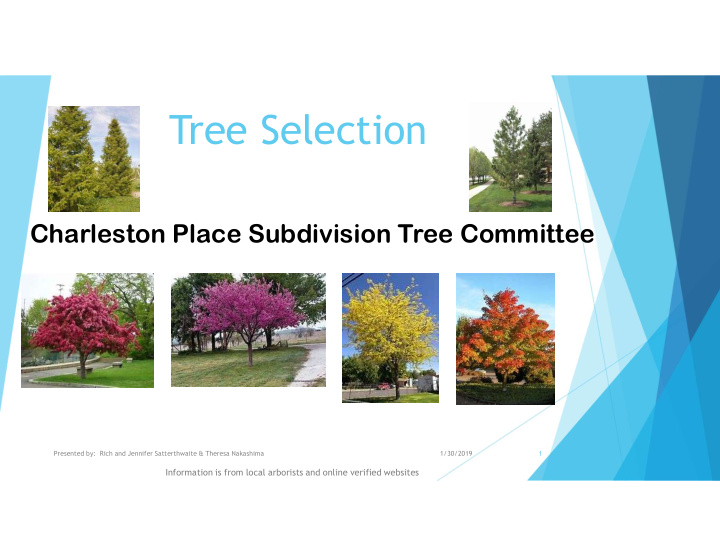



Tree Selection Charleston Place Subdivision Tree Committee Presented by: Rich and Jennifer Satterthwaite & Theresa Nakashima 1/30/2019 1 Information is from local arborists and online verified websites
DECIDING FACTORS FOR SELECTING A TREE Select variety of species w/ no more than 10% of any one species insects and pests will kill entire species when infected Hardiness How well they do in HEAT and COLD Heat can kill a tree just as much as cold!! Idaho is Zone 5/6 Canopy density—spreads out at the top determines if grass will grow or will not grow in the canopy shadow Is sunlight getting through canopy ? 1/30/2019 2 Presented by: Rich and Jennifer Satterthwaite & Theresa Nakashima
DECIDING FACTORS FOR SELECTING A TREE CONT . 12” to 18” will provide a good Deep Root system Utility Lines No tree taller than 25 feet! –Look on 5 mile. Trees sold 3 ways Ball Container Bare root ---normally your fruit trees 1/30/2019 3 Presented by: Rich and Jennifer Satterthwaite & Theresa Nakashima
DECIDING FACTORS FOR SELECTING A TREE CONT . Locations to Consider Street -–intersection must be clear and visible Property owner-- encroachment, possible damage from overhanging branches Common area -- best for class II and class III Greater shade, less trees to plant = Money saving Other trees already established Site Evaluation Above ground Below ground (water lines, sewer , power, gas, cable, phone, soil type) Modify site or move location of new tree Maintenance (prevent overhang of branches on sidewalks, streets, private property) 1/30/2019 4 Presented by: Rich and Jennifer Satterthwaite & Theresa Nakashima
DECIDING FACTORS FOR SELECTING A TREE CONT . Planting close to sidewalks Roots become confined Best tree if close to sidewalk is Honeylocust Wet site tolerant tree Adapts to produce roots under payment (prevents cracking or uplifting of sidewalk) Uplifts sidewalk Stress on tree Shorter life Restricted growth due to soil Retrieved from: http://hort.ifas.ufl.edu/treesandhurricanes/powerpoint.shtml , University of Florida IFAS Extension, n.d, Urban Forest Hurricane Recovery Program Retrieved from: http://hort.ifas.ufl.edu/treesandhurricanes/powerpoint.shtml , University of Florida IFAS Extension, n.d, Urban Forest Hurricane Recovery Program 1/30/2019 5 Presented by: Rich and Jennifer Satterthwaite & Theresa Nakashima
DECIDING FACTORS FOR SELECTING A TREE CONT . Size to plant 1” caliper –grows fast and cheaper to buy 1 ½” caliper– slightly slower growth than 1” and little higher purchase price 2 ½” caliper or bigger—slower growth annually and price is more 15 gallon pot is the 1” to 1 ½” caliper 1/30/2019 6 Presented by: Rich and Jennifer Satterthwaite & Theresa Nakashima
PROPER REMOVAL Plant new trees 3 to 5 ft away from old place Voiding acid from decaying/dying tree Sawdust completely removed All old soil removed Excerpt below is from Jay Hayek, Extension Specialist, Forestry Department of Natural Resources and Environmental Sciences retrieved from: https://web.extension.illinois.edu/askextension/thisQuestion.cfm?ThreadID=15340&catID=199&AskSiteID=87 It is generally "not' recommended to plant a new tree over the top of a recently removed stump. Simply plant the new tree adjacent to the stump, but keep the new planting hole at least three feet away from the stump to allow your new tree ample growing/rooting space (i.e., new trees need adequate mineral soil with good fertility and drainage for proper rooting and water/nutrient uptake). The reason we generally don't want to plant new trees over the top of existing stumps in yard-like settings is rather simple: the new planting location will have limited mineral soil exposure and inadequate rooting depth for nutrient uptake and structural stability; the sawdust / mulch created from stump grinding has a high carbon to nitrogen (C:N) ratio, thus compromising nitrogen availability for the new tree; and, settling of the newly planted tree within the cavity of the recently ground stump. Presented by: Rich and Jennifer Satterthwaite & Theresa Nakashima 1/30/2019 7
TREE COMMITTEE RECOMMENDATIONS: 1. Remove all trees in 1st year 2. Reassess the area to verify if 43 new trees are truly needed 3. Keep new trees at least 10 ft away from vinyl fences. HOA paid a lot of money for these fences and we need to protect them Keep HOA tree branches from overhanging onto private home owners property 4. Plant new trees throughout subdivision to allow trees to all mature equally This will avoid one street or entrance looking better than another Work closer with Idaho Power when planting on 5 mile 5. Hire a tree service company to properly care for trees Annual pruning Fertilizing Mulch if needed based on tree being planted Presented by: Rich and Jennifer Satterthwaite & Theresa Nakashima 1/30/2019 8
Resources Ryan Rodgers, ISA Certified Arborist –Boise works for the city Email: rrodgers@boisecity.org https://species.itreetools.org/ http://treesaregood.com http://www.treesaregood.org/ Presented by: Rich and Jennifer Satterthwaite & Theresa Nakashima 1/30/2019 9
Recommend
More recommend